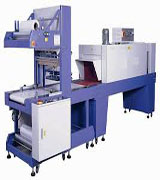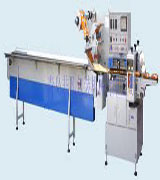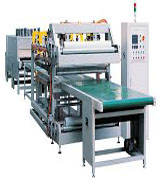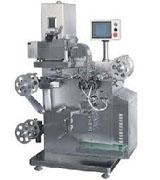A device designed for the assembly of unit loads from individual items. Usually a part of automated assembly lines, packaging machines arethe final step in the manufacturing process and the first step in the transportation process. They may be automatic or semiautomatic and canhandle materials packaged in rigid, semirigid, or soft containers and materials not packaged in containers, such as metal castings, sheetmetal, rolled metal sections, and lumber. The machines can be set up to handle items of a given standard size or items within the samerange of standard sizes, with the necessary adjustments being made either manually or automatically. They can be used to make up unitloads on auxiliary devices, such as pallets or skids. There are machines that only assemble loads, and there are machines that bothassemble and break up loads.
There is great variety in the design of packaging machines. Among the factors that influence design are the specific features of themanufacturing process and the properties and dimensions of the goods. The unit load consists of a stack of individual items that have beencollected in sequence in accordance with the load-sorting plan, which determines the relative positions of the items. Further development ofthe design of packaging machines has been based on matching the dimensions of packaging materials to those of the as-yet-unpackagedgoods and on considerations of the size, shape, and weight of the unit loads. Such standardization makes it possible to select the optimalindustrial methods for machine packaging, which is, in turn, a prerequisite for the design of unified and universal packaging machines. Thefirst packaging machines appeared in the USSR and abroad during the 1940’s.
Packaging machines are used for the assembly of unit loads from sheet goods, from bulk goods in sacks, and from individual items in themetallurgical, printing, and wood-products industries. Such machines may be designed to assemble unit loads horizontally, vertically, or in amanner that combines horizontal and vertical operations. In machines designed for horizontal operation, the goods from the conveyor belt,guided by the distributor in accordance with the work plan, are conveyed into the collector. There the goods form a layer, which is moved bythe carriage of a twin-chain conveyor to the flaps of the stacking device. The flaps are then opened, the layer of goods is lowered onto thepallet, and the stacking device is readied to receive the next layer. After the last layer is stacked, the load proceeds to the delivery conveyorand from there to the exit conveyor. The distributor makes it possible to carry out sequential sorting of items of various standard sizesaccording to a variety of programs by making the required adjustments in the control system.
The productivity of Soviet and foreign packaging machines is as high as 2,000 unit loads per hour.
|




